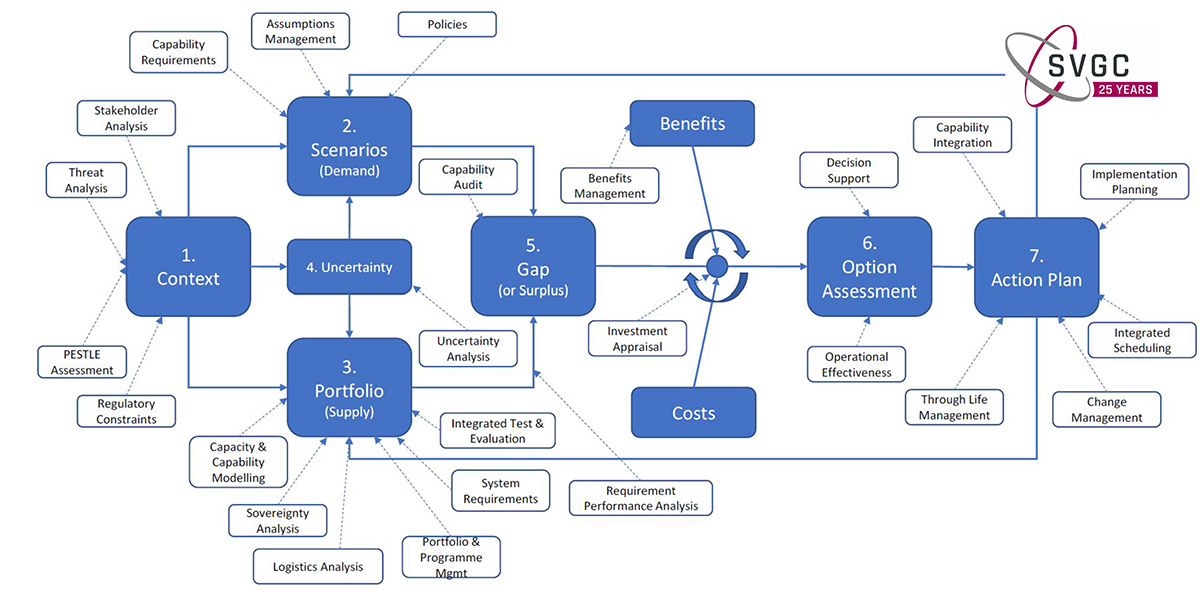What does Capability Management ACTUALLY mean? And why is it important?
At SVGC, we know very well the power of a highly skilled team and accredited expertise. But Capability Management is about so much more than purely looking at human resources and staff ability.
Our method focuses on the specific needs of an organisation and the desired achievements, analysing capacity and ability to enact an organisation’s target outcomes to deliver strategic goals. We like to think of our Capability Management services as Effect Based Strategic Planning.
Let’s start with some misconceptions of ‘Capability Management’.
The terms “Capability” and “Capability Management” are widely used throughout organisations in lots of different sectors and in many different ways.
Most recently, Capability Management has been interpreted as an umbrella term relating to people and skills within an organisation.
This approach might represent one aspect of “potential”, but what about the processes, systems, existing relationships, previous outputs and outcomes as well as collaborations and so on?
The potential development of any organisation is dependent on far more than just people and skills.
Our definition of Capability Management breaks it down into two key areas, capacity and ability. Put simply, ‘can I deliver enough of it?’ and ‘is it good enough?’ i.e. quality and quantity – and we focus this on the target outcome.
Our use of the term ‘Capability Management’ delves deeper than the umbrella terms, originating from the original definition of Capability Management which we had the privilege to develop back in 2004 within the Ministry of Defence. This definition was published in the 2005 Defence Industrial Strategy (DIS) [Ref 1], and some excellent papers in the Harvard Business Review (HBR) about strategic planning, output management and capability [internet versions Ref 2, 3].
When we work with a client to build their Effect Based Strategic Planning we break it down into two key areas, capacity and ability. By using the capacity and ability approach we can identify areas requiring focus and intervention – there might be the potential to deliver enough quantity (capacity), but not enough quality (ability). If there is not enough of either quantity or quality, there isn’t enough capability.
To enhance our Capability Management services we developed tools which include our “Integrated Capability Environments” that captures our approach and focuses on through-time capability management.
These methods have been shown to be adaptable to many different public sector organisations and other highly regulated organisations which have a strategic intent and require strategic planning.
At SVGC, we are experts in strategic business case delivery because we have 25 years of experience in applying methods such as this to some of the most complex capability challenges which exist in the UK.
Our experience within this area spans from Military Capability Management – creating and sustaining military effect – to considering how to create diplomatic effect around the world for the Foreign, Commonwealth and Development Office (FCDO), and even the effect of law enforcement.
The SVGC Effect Based Strategic Planning Method
The SVGC Effect Based Strategic Planning Method is based on long term outcomes spanning 5-50+ years, depending on the time frame of relevance to the organisation, but the method remains, using the 7 stages outlined below (click to enlarge).
- CONTEXT – The first step is about understanding the current and changing context using methods such as PESTLE analysis (political, economic, social, technological, legal and environmental). This stage looks at all the different aspects that make up the context of the organisation into which the target through-time outcome is to be established.
- DEMAND – At this stage we explore the long-term requirement. What is needed and how will that vary through time? We explore relevant policies, and evidence based assumptions about the future etc.
SUPPLY – What is available now and what is attainable? If nothing changes from the current plan what will we have in 5, 10, 15 years time? - UNCERTAINTY – Next we explore the uncertainties, context causes uncertainty as nothing is static. This inevitably impacts on the demand and supply, therefore planning needs to make sure the demand is able to be met taking into account the degree of plausible variability identified in the uncertainty stage. At this stage we use the cone of uncertainty to help identify the preposterous, possible, plausible and probable uncertainties.

- GAP ANALYSIS – Looking at the gap between Demand and Supply, it could be very small or very large depending on uncertainty. This is where we identify the needs to adapt to all situations.
- OPTION ANALYSIS – This stage looks at how you might solve the variables within the gap analysis and the cost benefits of different courses of actions. This enables evidence-based decisions to be made.
- ACTION PLAN – Finally an action plan can be drawn up for the actions recommended or decided upon.
Applying the SVGC Effect Based Strategic Planning method essentially writes the strategy for you and creates a solid foundation for strategic business cases which withstand scrutiny due to being built on solid foundations and evidence-based.
We consider what decisions have to be taken today to ensure a future scenario is available to be occupied – and the opposite – what ‘futures’ are no longer available to us as a consequence of decisions taken or not taken. There is no point trying to become a concert pianist when you have no basic piano training!
If you’d like to know more about how SVGC can help develop your Effect Based Strategic Planning, get in touch.
Further Reading
SVGC White Paper
Information Superiority for Capability Management
Dr Andrew Dixon and Richard Bryson
[Ref 1]
[Ref 2]
[Ref 3]
A simple demonstration of the methodology using a motor vehicle repair business
- CONTEXT – There is a long-term trend in increasing amount of information available to the general public through the internet about how to repair a car and there is an economic squeeze so the public have less cash; the second-hand car market is booming; new cars are becoming increasingly complex and reducing the amount the public can do themselves
- DEMAND – Long-term demand for maintenance of cars owned by members of the public, but as a consequence of the context, the types of maintenance is shifting
- SUPPLY – We provide all aspects of maintenance for cars
- UNCERTAINTY – It is not certain how much information available to the public is good quality or how confident the public feel about performing their own maintenance
- GAP – The public need good quality advice about maintenance for their cars; we have excess capability in basic maintenance which the public are more likely to do themselves; we need to be skilled in dealing with the potential mistakes made by the public who have some, but dangerously limited information
- OPTION – We could run courses to reinforce information to the public and provide advice about what they can and cannot tackle on new cars, and offer reduced maintenance costs if they have been trained in basic maintenance by us; we could become specialists in ‘solving the problems created at home’





